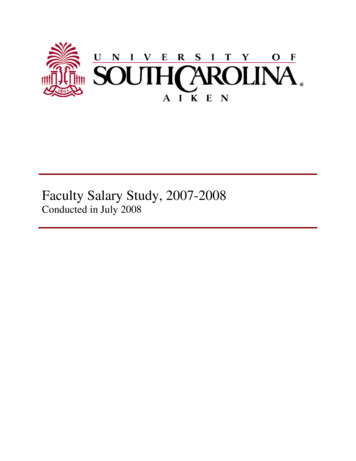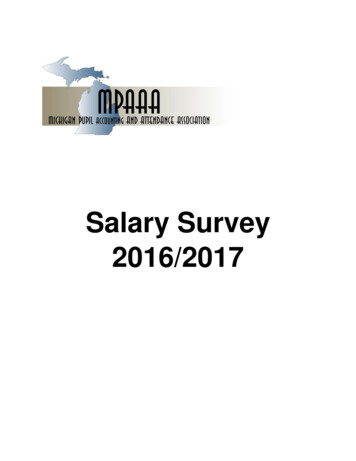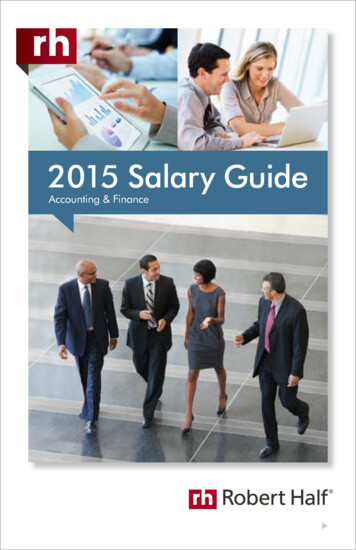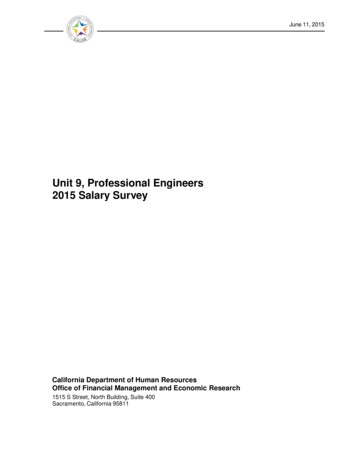
Transcription
Faculty Salary Study, 2007-2008Conducted in July 2008
University of South Carolina AikenDr. Thomas L. HallmanChancellorUniversity MissionFounded in 1961, the University of South Carolina Aiken (USCA) is a comprehensive liberal arts institution committed to activelearning through excellence in teaching, faculty and student scholarship, research, creative activities and service. In thisstimulating academic community, USCA challenges students to acquire and develop the skills, knowledge, and values necessaryfor success in a dynamic global environment.The university offers degrees in the arts and sciences and in the professional disciplines of business, education, and nursing. Allcourses of study are grounded in a liberal arts and sciences core curriculum. USCA also encourages interdisciplinary studies andcollaborative endeavors.Emphasizing small classes and individual attention, USCA provides students with opportunities to maximize individualachievement in both academic and co-curricular settings. The institution challenges students to think critically and creatively, tocommunicate effectively, to learn independently, and to acquire depth of knowledge in chosen fields. The university valueshonesty, integrity, initiative, hard work, accomplishments, responsible citizenship, respect for diversity, and cross-culturalunderstanding.USC Aiken attracts students of varying ages and diverse cultural backgrounds who have demonstrated the potential to succeed ina challenging academic environment. In addition to serving the Savannah River area, USCA actively seeks student enrollmentfrom all parts of South Carolina as well as from other states and countries.As a senior public institution of the University of South Carolina, USCA combines the advantages of a smaller institution withthe resources of a major university system. Located in beautiful, historic Aiken, South Carolina, USCA is an institution ofmoderate size (2,500-5,000 students) that offers baccalaureate degrees in a number of disciplines, completion baccalaureatedegrees at University of South Carolina regional campuses, and master’s degrees in selected programs.The USCA World Wide Web Home Page is: http://www.usca.eduThe USCA Office of Institutional Effectiveness World Wide Web Home Page is: http://ie.usca.eduJuly 2008Suggested CitationDawe, L.A. (2008). Faculty Salary Study, 2007-2008. Aiken, SC: Office of Institutional Effectiveness, University of SouthCarolina Aiken. Retrieved [date], from .Contact InformationOffice of Institutional Effectiveness101 Humanities & Social Sciences BuildingThe University of South Carolina Aiken471 University ParkwayAiken, SC 29801Faculty Salary Study (2007-2008)2
Table of ContentsExecutive Summary 4Methodology .Overview of USCA Faculty Salaries. .Botsch Folsom Competitiveness Comparisons . .Gender and Race/Ethnicity Inequity Comparisons . Compression Adjustment Salary Comparisons . .514192225Works Cited 29Appendix A: Legislated Percent Increases 1987-2007. .Appendix B: Inequity Percentage Comparisons By Individual (Personally IdentifiableInformation Removed .Appendix C: CUPA-HR National Faculty Salary Survey: Multi-Discipline Report .Appendix D: Salary Inequity Calculations (Personal Information Included)* .Appendix E: Compression Adjustment Salary Inequities* .Appendix F: Inequity Percentage Comparisons* .303136404142*Tables with personally identifiable information are provided only to senior administration andare not included in the World Wide Web version of the report.Faculty Salary Study (2007-2008)3
Executive SummaryIn order to examine the distribution and change in faculty salaries and to assist in making fairand equitable adjustments to the compensation structure, the Office of Institutional Effectivenessconducts an annual study of faculty salaries. This document reports the findings of that study forfaculty salaries during the 2007-08 academic year. This study is historical in nature bycomparing actual salaries against the average salaries of faculty in a broad peer comparisongroup; it does not take into account projected salary increases mandated by the legislature for2008-09. In addition to providing the usual comparison of “inequity percentages,” this study alsoincludes an examination of the effects of salary compression as well as potential salary inequitiesrelated to race and gender. Major findings include:¾ The mean salary of all full-time faculty, excluding librarians, at USC Aiken rose from 55,272 in 2006-07 to 56,273 in 2007-08, for an overall increase of 1.8%. The mean salaryof Full Professors rose 6.1% to 75,276; the mean salary of Associate Professors rose 0.3%to 60,166; the mean salary of Assistant Professors rose 1.2% to 49,905; and the meansalary for Instructors decreased 0.4% to 43,915.¾ Among all institutions in South Carolina, USC Aiken’s 2007-08 faculty salaries ranked #5for Instructors, #12 for Assistant Professors, #11 for Associate Professors, and #9 for FullProfessors.¾ The mean inequity percentage, with appropriate adjustments for Full Professors with lessthan the average time in rank, was -5.2%, indicating that faculty members at USC Aiken arepaid less than they would be expected to be paid. Mean inequity percentages variedsignificantly by faculty rank. The mean salary of Instructors was 2.9% higher than expected.For Assistant Professors the mean inequity percentage was -5.8%, down from -4.1% in 200607. The inequity percentage for Associate Professors dropped significantly to -10.6% from 7.2% in 2006-07. For Full Professors, the inequity percentage dropped to -7.7% (after specialadjustments were made for faculty with less than 12 years of service) from -3.6% in 2006-07.¾ Although males had an average salary slightly higher than females ( 59,743 compared to 52,356), they also had a larger negative salary inequity. Overall, females were only 5.0%under the expected salary for their professional rank, time in rank, and discipline, whilemales were 5.3% below their expected salaries. The observed differences approachedstatistical significance.¾ Similar to findings from previous Faculty Salary studies, this study found a statisticallysignificant effect of race based upon the unadjusted Botsch Folsom inequity statistic. Thefinding was less robust when special adjustments were made for Full Professors with lessthan the average number of years in rank, but the pattern was the same. While both groups offaculty had lower than expected salaries, on average and relative to their expected salariesbased upon the Botsch Folsom formula, nonwhite faculty members had salaries that werecloser to that which was expected (1.4% below) than white faculty (5.7% below).¾ The mean compression adjustment inequity percentage for all tenured and tenure-trackfaculty in 2007-08 was -6.9%, down from -6.1% in 2006-0706. Findings again appear toindicate that salary inequities related to compression are not widespread but rather observedamong disciplines such as business and some sciences.Faculty Salary Study (2007-2008)4
MethodologyThe methodology of the annual study of faculty salaries at USC Aiken was realigned in 2005under guidance from the Faculty Welfare Committee (Hosch, 2005). The 2008 study of 2007-08faculty salaries largely replicates the methodology of previous studies, with some minormodifications. The study examines salaries of full-time faculty at USCA using two separateformulas to address three issues. These issues are: 1) salary competitiveness with similarinstitutions, 2) salary equity along lines of gender or race/ethnicity, and 3) salary compressiondue to market forces (McLaughlin & Howard, 2003). The first formula, used in this study tomeasure competitiveness as well as gender/race inequity, was based upon one approved by theUSCA faculty in the late 1980s and published in the CUPA Journal (Botsch & Folsom, 1989).The majority of this study uses this first formula. The second formula was developed as acollaborative endeavor between the Office of Institutional Effectiveness and the Faculty WelfareCommittee in 2004-05 to account for salary compression. Based on a recommendation from theFaculty Welfare Committee in 2006-07, an additional calculation for Full Professors with lessthan the institutional mean years in rank is provided in this study.Comparison Group InstitutionsBoth formulae rely upon comparing a faculty member’s salary in some way to the salaries offaculty members in their discipline at all public Carnegie Bachelor’s and Master’s institutions innine states in the Southeastern United States. These states are Alabama, Georgia, Kentucky,Louisiana, Mississippi, North Carolina, South Carolina, Tennessee, and Virginia. This regionallimitation controls for cost of living differences in the Northeast and the West that could serve asa confounding factor in this study. For 2007-08, a total of 60 institutions comprised thecomparison group:Albany State University (Albany, GA)Appalachian State University (Boone, NC)Auburn University at Montgomery (Montgomery, AL)Augusta State University (Augusta, GA)Austin Peay State University (Clarksville, TN)Christopher Newport University (Newport News, VA)Clayton State University (Morrow, GA)Coastal Carolina University (Conway, SC)College of Charleston (Charleston, SC)Columbus State University (Columbus, GA)Eastern Kentucky University (Richmond, KY)Elizabeth City State University (Elizabeth City, NC)Fayetteville State University (Fayetteville, NC)Francis Marion University (Florence, SC)Georgia College & State University (Milledgeville, GA)Georgia Gwinnett College (Lawrenceville, GA)Georgia Southwestern State University (Americus, GA)Grambling State University (Grambling, LA)Jacksonville State University (Jacksonville, AL)James Madison University (Harrisonburg, VA)Kennesaw State University (Kennesaw, GA)Kentucky State University (Frankfort, KY)Lander University (Greenwood, SC)Longwood University (Farmville, VA)Louisiana State University in Shreveport (Shreveport, LA)McNeese State University (Lake Charles, LA)Faculty Salary Study (2007-2008)Nicholls State University (Thibodaux, LA)Norfolk State University (Norfolk, VA)North Carolina Central University (Durham, NC)Northern Kentucky University (Highland Heights, KY)North Georgia College & State University (Dahlonega, GA)Northwestern State University (Natchitoches, LA)Radford University (Radford, VA)Southeastern Louisiana University (Hammond, LA)Southern University A&M Coll. at Baton Rouge (Baton Rouge, LA)Tennessee Technological University (Cookeville, TN)The Citadel, The Military College of South Carolina (Charleston, SC)The University of Virginia's College at Wise (Wise, VA)The University of West Alabama (Livingston, AL)Troy University (Troy, AL)University of Louisiana at Monroe (Monroe, LA)University of Montevallo (Montevallo, AL)University of North Alabama (Florence, AL)University of North Carolina at Asheville (Asheville, NC)University of North Carolina at Charlotte (Charlotte, NC)University of North Carolina at Pembroke (Pembroke, NC)University of North Carolina at Wilmington (Wilmington, NC)University of South Carolina - Aiken (Aiken, SC)University of Tennessee at Chattanooga (Chattanooga, TN)University of Tennessee at Martin (Martin, TN)University of West Georgia (Carrollton, GA)Valdosta State University (Valdosta, GA)5
Mississippi University for Women (Columbus, MS)Mississippi Valley State University (Itta Bena, MS)Morehead State University (Morehead, KY)Murray State University (Murray, KY)Virginia Military Institute (Lexington, VA)Western Kentucky University (Bowling Green, KY)Winston-Salem State University (Winston-Salem, NC)Winthrop University (Rock Hill, SC)Average 2007-08 salaries of faculty by rank and discipline from this cohort group of similarinstitutions were obtained from the College and University Professional Association for HumanResources (CUPA-HR) Online Surveys Application in late June of 2008. CUPA-HR reportssalary data by discipline (2-digit code) and sub-discipline (4-digit code). In almost all instances,USC Aiken faculty members were compared to their regional peers in their specific subdiscipline. When regional data were not available from CUPA-HR for a specific sub-discipline,a wider “net” was cast and faculty were compared to their sub-discipline peers on a Nationalbasis.Study Population and Salary DataIndividual salaries of USCA full-time faculty members were collected from the HumanResources file on the USC mainframe and confirmed with the USC Aiken Human ResourcesOffice. Administrative supplements were removed from all salaries to determine base salaries.For faculty whose pay basis is other than nine months, base salaries were converted to ninemonth salaries using a methodology promoted by the American Association of UniversityProfessors (AAUP). Importantly, AAUP methodology treats 12-month faculty salaries as thoughthey were 11-month salaries by multiplying them by 0.8181 rather than by 0.75. Facultymembers included in the analysis held academic rank as described in the USCA Faculty Manual(5.2.8) and primarily have responsibilities for teaching or research. For instance, DepartmentChairs were included in the analysis (minus their administrative supplements), but Deans andsenior administrators who hold faculty rank and whose primary duties are not instruction orresearch, such as the Executive Vice Chancellor for Academic Affairs, were not.Librarians were also included in this study, but they were treated separately from faculty whoseduties primarily involve classroom teaching. The salaries of librarians were compared to those ofother librarians at four-year colleges in the South Carolina as reported in the American LibraryAssociation Survey Report (Grady, 2007); comparison salaries from South Carolina were used inplace of the regional mean salaries in the Southeast because the regional salaries appeared lowerthan those in the state. Because this data source reports 12-month salaries for librarians by regionand institution type, the salaries of USC Aiken librarians were not adjusted to 9-monthequivalent salaries for formula comparisons.In 2006-07, in the schools of Business, Education, and Nursing, the title of the unit leaders werechanged from School “Head” to “Dean.” This change excluded them from reporting of salariesfor instructional faculty to AAUP and to IPEDS. Their salaries appear in Appendix D but are notincluded in the overall calculations presented in this study.Last year’s Faculty Salary Study was the first year in which the full compensation of Instructorswho were teaching 15 credit hours was adjusted to 12 hour contracts. Because this adjustment isnot made in reports to AAUP, CUPA-HR, or the U.S. Department of Education from whichcomparison data are drawn, this year’s study returned to the previous practice of including fullcompensation for instructors.Faculty Salary Study (2007-2008)6
Botsch Folsom Formula and Competitiveness ComparisonsThe Botsch Folsom Formula compares each USCA faculty member’s salary to the mean salaryof faculty in the same sub-discipline at that rank at institutions in the comparison group afteradjusting this mean salary to account for the USCA faculty member’s time in rank. The formulagenerates for each faculty member an “inequity percentage” that represents how far above orbelow an individual’s salary varies from the formula-generated expected salary. The intendedapplication of this formula is to address discrepancies between salaries at USCA and facultysalaries at similar institutions with which USCA may compete for faculty. This formula wasdeveloped from eleven principles of fairness as discussed in Botsch and Folsom (1989).The formula to generate the inequity percentage is published in Botsch & Folsom (1989, 46).Any modifications to the published formula are noted. 1% Inequity (Faculty Member’s Pay) – TAPGATAPGAX 100%TAPGA stands for time adjusted peer group average, and is the peer group average adjusted fortime in rank, expressed mathematically as follows:TAPGA PGA YRINC (TIMRNK – AVTIMRNK), wherePGA is the peer group average, using the peer comparison group ofbaccalaureate and master’s institutions listed above; these data wereobtained from CUPA. 2YRINC is the yearly increment for each rank. This was calculated as what theaverage percentage raises were for the last ten years (2.75%)multiplied by the average salary at each rank and then rounded to thenearest 100. For the 2007-08 study, these increments appear in3Table 1 .1The most notable change in the formula from that used in previous Faculty Salary Studies is that TAPGA is beingsubtracted from the faculty member’s pay, rather than having the faculty member’s pay subtracted from TAPGA asis done in Botsch & Folsom (1989). This minor modification to the formula simply changes the sign associated withthe difference and thus the sign of the inequity statistic. In the past, a negative inequity percentage indicated afaculty member’s salary was above that of peers, while a positive statistic meant the salary was below. Thiscounter-intuitive result could lead to interpretive problems. The minor modification to the formulae addresses thisconcern resulting in positive values indicating a salary above that which would be expected, and negative valuesindicating salaries below expectation.2Botsch & Folsom (1989) indicates that this comparison group should be a “national peer group.” For reasons notedabove, this peer group was expanded by number of institutions but limited to nine states in the Southeastern U.S.Further, average salaries for each rank were always used rather than making special adjustments for fields wherestarting salaries exceeded the average salary. The compression adjustment formula makes an attempt to control forthis phenomenon.3The published Botsch Folsom formula does not consider instructors. Additionally, it also indicates that a five-yearaverage for raises should be used to calculate the average increment. However, this study continues to use a 10-yearaverage of annual raises to maintain some consistency with previous years as well as to stabilize variation acrossperiods of fiscal restraint and expansion (see Appendix A).Faculty Salary Study (2007-2008)7
Table 1. Yearly Increment by Rank for 2007-08RankInstructorsAssistant ProfessorsAssociate ProfessorsFull ProfessorsYearly Increment 1,200 1,400 1,700 2,100TIMRNK is the time in current academic rank including the current year, witha maximum of six for assistant and associate professors. 4AVTIMRNK is the average time in rank. For Assistant and AssociateProfessors, this average is automatically set at 3 years. For Instructorsand Full Professors, the average time in rank is calculated from dateof hire as a full-time instructor or date of promotion to Full Professor.For 2006-07 these figures appear in Table 2.Table 2. Average Time in Rank for USC Aiken FacultyFaculty RankInstructorAssistant Prof.Associate Prof.Full Professor2006-077511122007-08751012Average Years in RankUsed in 2007-08 Study73312Botsch Folsom inequity calculations for individual faculty members are listed in Appendices Band D through F. Appendix B lists faculty members in each rank by an anonymous ID number(this number is altered each year); this Appendix is included in the broad release of this study.Appendices D through F contain sensitive information about salaries in a format that personallyidentifies individuals, and so these Appendices are released only to senior administrators. Sinceidentities of faculty who received promotions or post-tenure review adjustments may be easilyidentified, supplementary calculations for these faculty in their new ranks or at their new salariesappear in Appendices D through F only.Salary Equity Comparisons By Gender and Race/EthnicityPotential salary inequities related to gender and race or ethnicity have been examined since the2004-05 salary study, and these factors are again examined in the 2007-08 study of facultysalaries. The Botsch Folsom formula described above provides a means to conduct this analysisbecause it generates an expected salary for each faculty member based on a disciplinary averageand time in rank. The resulting inequity percentage represents the difference between the actualsalary and expected salary as a proportion of the expected salary, and this percentage thusrepresents a normalized residual that can provide reasonable comparisons among facultymembers across various characteristics.4The published formula indicates that any time in current rank at another university should also be credited towardeach faculty member, but these data are not consistently tracked for all faculty members and so are not included inthis study.Faculty Salary Study (2007-2008)8
This study provides an overall analysis of salaries using the Botsch Folsom inequity percentageby gender and by race or ethnicity. Given the relatively small numbers of faculty members whoare members of a minority racial or ethnic group, the analysis by race or ethnicity is conductedonly along the cleavage of white/nonwhite, where international faculty of European/Caucasiandescent are categorized as white. The relatively small number of nonwhite faculty limitsmeaningful analysis of salaries across some of these demographic characteristics. In this year’sstudy, the inequity rates were submitted to a 2 (gender: male, female) x 2 (race/ethnicity:minority, white) x 4 (rank: instructor, assistant, associate, full professor) analysis of variance.Post-hoc analyses of significant findings for Rank were conducted using Tukey’s HSDmethodology.Salary Equity Comparisons for Full Professors with Fewer than 12 Years in RankThe Faculty Welfare Committee in 2006-07 approved the use of an additional calculation forFull Professors with fewer than the mean number of years in rank (12 years in this study). Thisadditional calculation is intended to account for a sharp drop in the Botsch Folsom formulaexpected salary when a faculty member is promoted from Associate Professor to Full Professor,as seen in Chart 1a. The special calculation formula is:SpecSalFP BFSalAssoc [ (YrsRankFP / YrsMeanFP) X (MeanSalFP – BFSalAssoc) ], whereSpecSalFP is the special predicted salary for Full Professors with fewer than the meannumber of years in rank at Full Professor.BFSalAssoc represents the Botsch Folsom expected salary for a faculty member at theAssociate Professor level with 6 years in rank as an Assoc. Professor.YrsFP indicates the faculty member’s years in rank as a Full ProfessorYrsMeanFP is the mean years in rank of all USC Aiken Full ProfessorsMeanSalFP is the mean salary in the peer group in the faculty member’s discipline at therank of Full ProfessorThis “under-mean adjusted” equity line generated by this formula is represented as the dotted redline in Chart 1a, which depicts an adjusted distribution of Botsch Folsom expected salaries forFall 2007 compared to institutional average salaries.Faculty Salary Study (2007-2008)9
Chart 1a. Representation of Actual Faculty Salaries in Fall 2007 By Time in Rank*Compared to Botsch Folsom Predicted Salaries 120,000 100,000 80,408 80,000 65,431 60,000 54,844 40,000 20,000Asst ProfAssoc Prof24232221201918171615141312119108765432156 432156 4321 0Full ProfFull ProfessorMean SalaryBotsch Folsom Expected SalaryEquity Line* Assistant and Associate Professors with more than 8 years of time in rank are excluded from this chart.Salary Equity Comparisons Using a Compression Adjustment FormulaAt the recommendation of the Faculty Welfare Committee, this study examines USC Aikenfaculty salaries using a formula to identify salary compression in certain disciplines. Salarycompression is a broad term that refers to situations in any industry in which the starting salariesof newer employees approach, meet, or exceed employees with greater lengths of service. Salarycompression typically occurs in areas where there is a shortage in the labor supply (Knight &Sabot, 1987).In higher education, this phenomenon is most observable where the starting salaries of newAssistant Professors exceed the mean salaries for Assistant Professors, or when the mean for allAssistant Professors nears or exceeds the mean for Associate Professors in the same discipline.For instance, among the institutions in the 2007-08 peer comparison group, the average startingnine-month salary for a new Assistant Professor of Finance was 98,538, which is about 7%higher than the mean salary of 91,612 for all Assistant Professors in the discipline and 4%higher than the mean salary of 94,621 for all Associate Professors in this discipline. Indeed, themean salary of Full Professors is just 8% higher than the mean for new Assistant Professors (seeTable 3). Such compression among salaries can have detrimental effects on faculty morale, canprovide incentives for faculty members to move to another institution, and can pose difficultiesin devising equitable ways to compensate faculty members.Faculty Salary Study (2007-2008)10
Table 3. Salary Compression – 2007-08 CUPA Peer Group Mean Salaries (Finance)52.08 FinanceProfessorAssociate ProfessorAssistant ProfessorNew Assistant ProfessorN68525413Comparison Group Statistics from CUPA(Based on Reported Average Salaries)Average% of New Asst Prof 106,282108% 94,62196% 91,61293% 98,538100%Data Source: CUPA-HR – see Appendix C.Typical methods for determining inequities resulting from salary compression at an institutioninclude: cross-sectional comparisons across departments, time series comparisons of junior tosenior faculty members, and linear regression of salaries or the logarithm of salaries to meansalaries of assistant professors in a comparison group to determine an expected salary and aresidual (Toutkoushian, 1998; Haignere, 2002). The present study relies primarily on a timeseries comparison of faculty salaries across ranks to a normative ratio of salaries among facultyranks. Each faculty rank’s average salary was compared to that of an Assistant Professor,resulting in an appropriate ratio. While the mean salary for Assistant Professors within adiscipline is sensitive to market conditions, averaging across disciplines maintains some stabilitybecause of the large size of the group. These data for 2007-08 were obtained from AAUP (2008)(see Table 4). The resulting ratios indicate that mean salaries of Associate Professors are 119%of the mean for Assistant Professors and the mean salaries of Full Professors are 147% of themean for Assistant Professors. The annual ratios have remained within 2 percentage points overthe past 5 years, suggesting that this is a relatively stable indicator. These data suggest that onaverage, an Associate Professor should be paid about 19% more than an Assistant Professor, anda Full Professor should be paid 47% more than an Assistant Professor.Table 4. Mean Salaries Across Disciplines in at Baccalaureate Institutions,Nationwide, Fall 2007Academic RankFull ProfessorAssoc. ProfessorAsst. ProfessorInstructorMean Salary 80,408 65,431 54,844 44,349Percentage of Asst. Professor Salary147%119%100%81%Data Source: AAUP Salary Survey results posted on The Chronicle of Higher Education website (2008)Increases in these salaries were projected over 30 years, assuming that these ratios should remainmore or less constant over time and that the average annual cost of living salary increase wouldbe 2.4%. The salary of a hypothetical faculty member was then drawn onto these projected salarycurves so that salary over his or her career would intersect the curves at the mean salary for rankat appropriate times. This hypothetical faculty member was assumed to have been hired at theCUPA average for Assistant Professors. This is in keeping with recent practice at USCA to hirestarting Assistant Professors at or near this value. It was also assumed that the hypotheticalfaculty member would adhere to a regular promotion schedule, earning the rank of AssociateProfessor after six years and the rank of Full Professor after another six years. Normative salaryincreases of 3500 for promotion to Associate Professor and 5,000 at promotion to FullFaculty Salary Study (2007-2008)11
Professor were included 5 . The best-fit curve, where the hypothetical faculty member’s salaryintersects an Associate Professor rank’s mean salary at 3 years and a Full Professor’s meansalary at 9 years in rank, reflects an annual increase of 3.8%.Chart 1b. Projected 30 Year Salary Curves, 2007-2036 andSalary of a Hypothetical Faculty Member 180,000 160,000 140,000 120,000 100,000 80,000Est. CUPA Asst. ( 100%)Est. CUPA Assoc ( 119% of Asst.)Pretend Faculty MemberEst. CUPA Instructor ( 5432 40,0001 60,000Est. CUPA Full ( 147% of Asst.)Given that salary increases are awarded as percent increases, salaries graphed over time representlogarithmic functions (see Chart 1b). As more senior faculty members spend more time at therank of professor, their expected compensation will rise significantly above the mean. Since lifeexpectancies and retirement ages will likely increase over time, some artificial caps may beappropriate for long-term planning, as an increasing number of faculty members may spend morethan 25 years as Full Professors. To account for this eventuality, the 2008 salary inequity studylimits the compression adjustment formula to 161.7% of the Assistant Professor Salary (or 10%more than the normatively calculated Full Professor’s average salary).This normative approach produces an expected ratio between a faculty member’s salary at agiven point in his or her career and the salary of a starting Assistant Professor in t
Morehead State University (Morehead, KY) Winston-Salem State University (Winston-Salem, NC) Murray State University (Murray, KY) Winthrop University (Rock Hill, SC) Average 2007-08 salaries of faculty by rank and discipline from this cohort group of similar











